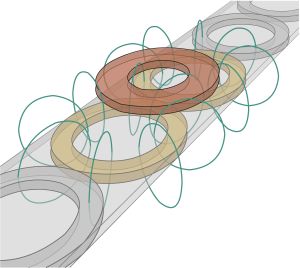Inductive energy transfer is part of our everyday life: Electric tooth brushes, for instance, are supplied with electricity from a charging station by electromagnetic transfer without any cable connection. Scientists of the KIT Institute of Vehicle System Technology study how this process can also be used in railroad and road traffic. The new technology may replace overhead lines in the long term. This will allow for an increased flexibility of the vehicles in urban traffic.
Trams are supplied with electricity via a pantograph, i.e. a unit of the vehicle that transfers electricity from the overhead line to the electric installations of the vehicle. Wind, rain or snow may adversely affect the function of the overhead lines. “This method is associated with the drawback of the connections being subject to high mechanical loads and high wear due to friction,” explains Professor Peter Gratzfeld, one of the heads of the Institute of Vehicle System Technology. “Moreover, overhead lines disturb the cityscape, for instance, by obstructing the view of a historical building.”
This is one of the reasons why the group of researchers directed by Gratzfeld is looking for new methods to supply trams with the necessary electric energy. It was already successfully demonstrated in experiments that inductive transfer of more than 100 kW of power works technically. This power may be transferred both while the tram is stopping and while it is driving. Inductive energy transfer takes place according to the laws of electromagnetic induction via two coils: One coil (primary coil) is positioned between the rails, the second coil (secondary coil) at the bottom of the vehicle. Change of the magnetic flux induces an electric voltage in the coils. Energy transfer between both coils therefore works in a contactless manner. At the interface, wear due to friction is excluded.
It is the objective of the research group to transfer this technology of inductive energy transmission from trams to other vehicles. “Buses are highly suited for this purpose, as they move on fixed routes in the city area. This means that the vehicles can be recharged at the stops while the passengers are getting on and off or during the drive,” explains Peter Gratzfeld. This technology may even be applied to electric vehicles in the future. As car drivers only move their cars for one hour per day on the average, parking lots might be used as charging stations.
The scientists also consider the protection of man and animals against electromagnetic fields. In spite of high transmission rates, the valid limit values shall be observed in areas near the vehicles that can be accessed by people. This is achieved by specially developed coil geometries. Hardware and software ensure that the primary coil is switched on only when the vehicle is located above.
The scientists of the Institute of Vehicle System Technology contribute their expertise to various projects: In the field of public passenger transport, they cooperate with the company Bombardier Transportation. Aspects of the use of inductive energy transmission in private cars are part of the BIPoL project (Contactless, Inductive, and Position-tolerant Charging Concept for Electrically Driven Vehicles), which is funded by the Baden-Württemberg Ministry of Economics.
Further information is available at www.bahnsystemtechnik.de.
The Mobility Systems Center pools KIT activities relating to vehicle technology. Presently, 40 KIT institutes with about 800 employees are working on methodological and technical fundamentals for tomorrow’s vehicles. It is their objective to develop energy-efficient, low-emission, and safe vehicles and mobility concepts. The researchers also consider the complex interactions of vehicle, driver, traffic, and society.
Under the heading of “Future Mobility”, KIT will present its scientific activities on its new “Campus East – Mobility and Innovation” during an Open Day on July 02. More information can be found at: www.pkm.kit.edu/3072.php
In close partnership with society, KIT develops solutions for urgent challenges – from climate change, energy transition and sustainable use of natural resources to artificial intelligence, sovereignty and an aging population. As The University in the Helmholtz Association, KIT unites scientific excellence from insight to application-driven research under one roof – and is thus in a unique position to drive this transformation. As a University of Excellence, KIT offers its more than 10,000 employees and 22,800 students outstanding opportunities to shape a sustainable and resilient future. KIT – Science for Impact.

